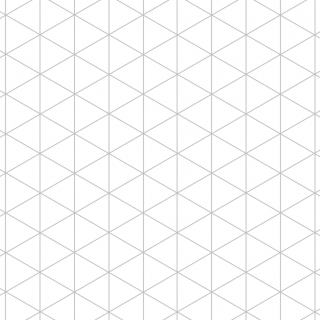Isometric printable paper is a specialized type of graph paper that features a grid with evenly spaced horizontal and vertical lines, creating a three-dimensional isometric perspective. Unlike traditional graph paper, which typically has square grids, isometric paper has grids that are oriented at a 60-degree angle to each other. This unique grid layout allows for the accurate representation of objects in three dimensions, making it a valuable tool for various design and drawing applications.
Purpose of Isometric Printable Paper
-
Perspective Drawing: Isometric paper is primarily used for perspective drawing. It provides a structured framework for artists, architects, engineers, and designers to create three-dimensional sketches and illustrations. This perspective is especially useful for visualizing objects, buildings, and machinery accurately.
-
Engineering and Technical Diagrams: Engineers and technical illustrators use isometric paper to create detailed diagrams, schematics, and plans. It aids in the precise depiction of complex structures, machinery, and assemblies, making it an essential tool for engineering design work.
-
Geometry and Mathematics: Isometric paper is a valuable aid for teaching and learning geometry and mathematics concepts related to three-dimensional shapes and spatial relationships. It allows students to practice drawing 3D figures and solving problems involving angles, proportions, and measurements.
-
Crafting and Model Building: Isometric paper is popular among hobbyists and craft enthusiasts who build models, dioramas, and miniature structures. It helps ensure accurate scaling and proportionality in model-making projects.
Use Cases for Isometric Printable Paper
-
Architectural Design: Architects can use isometric paper to sketch building layouts, floor plans, and elevation views in three dimensions. It assists in visualizing how various architectural elements come together.
-
Product Design: Industrial designers and product developers use isometric paper to create preliminary sketches of products and prototypes. It aids in conveying the design intent and dimensions of products accurately.
-
Game Development: Game designers and artists often use isometric perspective in creating game assets and level designs. Isometric paper is handy for sketching out game scenes and character concepts.
-
Education: Isometric printable paper is a valuable educational tool for teaching geometry, engineering, and technical drawing at various levels, from elementary school to college.
-
Interior Design: Interior designers can use isometric paper to create scaled room layouts, furniture arrangements, and interior design concepts.
-
Craft Projects: Crafters and hobbyists can employ isometric paper for crafting projects that require precise measurements and scaled drawings, such as building dollhouses or crafting custom packaging.
-
Prototype Development: Engineers and inventors use isometric paper for creating preliminary designs and prototypes of new inventions, helping to visualize and refine their ideas.
In summary, isometric printable paper serves as an indispensable tool for professionals and learners in various fields, enabling them to create accurate and visually compelling three-dimensional representations and diagrams. Its versatility makes it a valuable asset in design, engineering, education, and creative endeavors.
Download Isometric Papers
- Isometric Printable Paper 5 mm
- Isometric Printable Paper 10 mm
- Isometric Graph Paper 1/8 inch
- Isometric Graph Paper 1/4 inch
How to Use Isometric Printable Paper
-
Select the Appropriate Grid: The attached files come in various grid intervals, including 5 mm, 10 mm, 1/8 inch, and 1/4 inch. Choose the grid interval that best suits your needs based on the level of detail and scale required for your drawing or graphing project.
-
Printing Instructions: When printing the isometric paper, ensure that your printer settings are configured correctly. Use standard letter or A4-sized paper for printing. It's important to maintain the original size of the image without resizing it. Resizing the image will alter the scale of the grid and may affect the accuracy of your drawings.
-
Trimming: Depending on your printer's capabilities and margins, the printed isometric paper may extend beyond the page edges. If this occurs, it's advisable to allow the printer to crop the edges automatically. This ensures that the grid lines are maintained in their correct proportions.
-
Start Drawing or Graphing: Once you have printed the isometric paper, you can start using it for your intended purpose. Here's how to use it for common applications:
-
Perspective Drawing: Use the isometric grid as a guide to create three-dimensional sketches. The grid's 60-degree orientation allows you to accurately represent objects and structures in perspective. Each grid intersection represents a point in space, making it easy to draw straight lines and angles in the isometric view.
-
Graphing: Isometric paper is also suitable for creating isometric graphs or diagrams. You can use it to plot data points, create scaled diagrams, or visualize mathematical concepts in three dimensions.
-
-
Scale and Precision: Pay attention to the grid intervals when working on your project. The chosen grid interval (e.g., 5 mm, 10 mm, 1/8 inch, or 1/4 inch) determines the scale of your drawings or graphs. Ensure that you maintain consistency in your measurements and angles to achieve accurate results.
-
Erasing and Editing: Isometric paper allows for precise drawing, but mistakes can still happen. Use erasers and drawing tools as needed to make corrections or refine your work.
-
Labeling and Annotations: If your project requires labeling or annotations, do so neatly and clearly to enhance the comprehensibility of your drawings or graphs.
-
Storage and Organization: After completing your work, consider storing your isometric paper sheets in a folder or binder for future reference or as part of your design or documentation portfolio.
By following these instructions and selecting the appropriate grid interval, you can effectively use isometric printable paper for perspective drawing and graphing, making it a valuable tool for various creative and technical projects.

